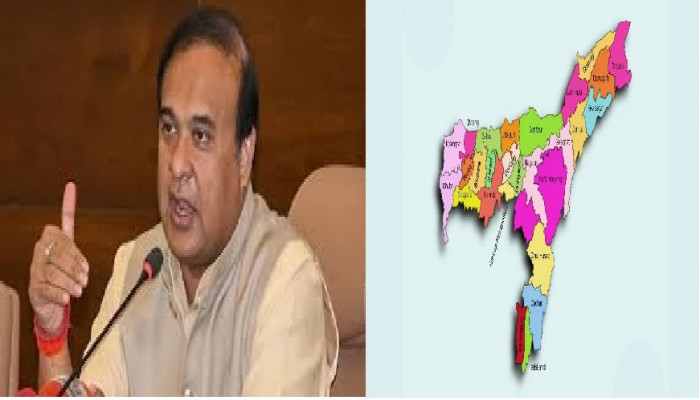The Assam Model of Averting Street Protests
- In Current Affairs
- 09:46 AM, Apr 19, 2025
- Ankita Dutta
Assam’s neighbouring state, West Bengal is burning again. The fire started all over again on quite expected lines immediately after the Waqf (Amendment) Bill, 2025, was passed in the Lok Sabha on April 3. Several areas in Bengal’s Murshidabad district are tense in the aftermath of the violence. Disturbing visuals of over 5000 Muslims gathering in the streets of Bengal to oppose the Act have been circulating online. Holding sharp sticks, knives and weapons in their hands, they could be heard raising hate-filled and provocative anti-Hindu slogans, while homes, private vehicles and public buses continue to be burnt and destroyed. Railway tracks have been blocked, and Government offices and properties destroyed.
Clearly, local Hindus of Murshidabad are again being deliberately targeted and displaced. As per news reports, several people were seen fleeing Murshidabad by boat, attempting to cross the river into neighbouring Maldah district in search of safety. Taking note of the failure of the law-and-order situation in the state, the Calcutta High Court too had stated that every citizen has the right to life, and it is therefore the responsibility of the state to ensure that their lives and properties are secured. Unfortunately, this show has been going on nakedly, with the State Police, security forces and the administration turning a blind eye to the cries of hapless Hindus.
It may be noted here that the draft of the Bill had been sent to a Joint Parliamentary Committee (JPC) for recommendations before it was finally passed in the Parliament. The Committee comprised of several members from the Muslim community and prominent leaders of different Muslim organisations and Muslim bodies. As a part of a nationwide tour of 10 cities undertaken by the Committee, important Muslim organisations and their representatives were consulted for feedback. Based on the feedbacks, the Bill was edited multiple number of times before it was finally passed in both the Houses of the Parliament as per appropriate constitutional procedures.
Therefore, claims raised by several quarters against the Bill being ‘undemocratic’ does not hold ground. But, soon after the implementation of the Bill, many Islamic organisations, NGOs such as Association for the Protection of Civil Rights, and political leaders including Congress MP Mohammad Jawed, AIMIM President Asaduddin Owaisi, and AAP MLA Amanatullah Khan filed petitions against it in the Supreme Court of India, challenging its constitutional validity. The religious demography of both Assam and West Bengal is extremely unfavourable for Hindus. This is especially true with respect to the border districts of these states. It certainly appears irreversible.
Also, we should not forget that both states have a bloody history of violence and insurgency perpetrated by various anti-India forces at the behest of the successive Governments in power in the past. But, compared to West Bengal, how could Assam avert such massive anti-Waqf protests and violence? What made it possible? The efforts of the Assam Police under the astute leadership of Chief Minister Dr. Himanta Biswa Sarma are noteworthy in this regard. The Assam Police had strong intelligence that hinted at the probability of different places in the state going to witness some kind of anti-Waqf disturbance after the Jumma Namaz on Friday, the 11th of April.
During a press conference, Dr. Himanta Biswa Sarma stated that the Assam Police worked extensively on the intelligence inputs to avert any kind of violence. The Government’s plan of action involved approaching every single Muslim leader and Maulvis of Masjids across the state to initiate discussions with them. He hardened his stance on protests against the amended Waqf law by the Muslim community and categorically warned that the Government of Assam would not allow any stone pelting or street protest or mob demonstration. Any ordinary Assamese would agree that before the coming of Dr. Sarma to power, the Muslim appeasement policy was followed in Assam both overtly and covertly.
If we recall, the Assam Legislative Assembly Elections of 2021 were fought on the premise of ‘War of Two Civilisations’ – a phrase coined by Dr. Sarma himself during the campaigning for the elections. It gradually gained steam as the electoral prospects of the Congress-AIUDF alliance started becoming clear in the Muslim-dominated seats of the Barak Valley, a few districts of Central Assam, and Lower Assam. The BJP in Assam made use of the state’s Bhaona tradition, where the party leaders were seen taking a vow to protect the Assamese identity and the culture and civilisation of the state. It was a politically calculated move to unite and consolidate the Hindu vote of the state.
Being the master-strategist that Dr. Sarma is, he understood very well that the sentiments of the Assamese people had to be effectively channelised, not only to ensure the defeat of the Congress-led Grand Alliance but also to make the electoral prospects of the BJP stronger in the Brahmaputra Valley. Unapologetically, he had made the issue of protecting the Assamese culture and civilisation from Islamic demographic expansion the battle cry of the Assam Assembly Elections, 2021. He boldly declared that he does not seek votes from the 35% Mia (Bangladeshi Muslim) community in Assam to win elections, since they would never vote for him.
He also accused the Mias of being communal and posing an open threat to the Assamese culture and language and as well as the composite Bharatiya civilisation. It may be noted here that during the tenure of former Chief Minister Sarbananda Sonowal, in his capacity as the Education and Finance Minister of the Government of Assam, Dr. Sarma played a key role in the passing of the Assam Repealing Act, 2020 to abolish the Assam Madrassa Education (Provincialisation) Act, 1995 and the Assam Madrassa Education (Provincialisation of Services of Employees and Re-organisation of Madrassa Educational Institutions) Act, 2018.
Defying political correctness, he clearly stated that the Government of Assam can no longer spend public money in the name of madrassa education. True to his words, more than thousands of government and provincialised madrassas across 31 districts of the state till date have been converted into general schools under the Board of Secondary Education (SEBA), Assam. Coming to the present, in yet another significant move, the decades-old tradition of the Assam Legislative Assembly providing a two-hour break to enable Muslim legislators to offer namaz on Fridays has been discontinued for the first time during the last Budget session.
Chief Minister Himanta Biswa Sarma wholeheartedly supported the decision, emphasising that it prioritises economic productivity by moving away from “another vestige of colonial baggage,” a practice introduced by the Muslim League’s Mohammad Saadulla in 1937. With the removal of the Friday ‘namaz break’, the Assam Assembly would now function continuously from 9:30 A.M. onwards, similar to other weekdays. This change aligns with the broader push for uniform legislative procedures throughout Assam. Through his meticulous strategies of promoting the cultural heritage of the state by hosting events such as Jhumoir Binandini, he has transformed himself into the saviour of the indigenous people of Assam.
A product of the anti-foreigners’ movement of the 1980s, Dr. Sarma’s speeches are infused with a lively gusto that is enough to mould public opinion and also convince other Bharatiyas about the existential identity crisis of Hindus and the need for it to be protected. He has not only been able to consolidate the Hindu vote-bank but also politically divided the Muslims of Assam into two distinct groups – the indigenous Assamese Muslims and the Bangladeshis. In September 2022, the Assam State Cabinet had decided to accord the status of ‘indigenous Muslims’ or Khilonjiya Musalman to five Assamese Muslim sub-groups, i.e. Goriya, Moriya, Deshi, Jolha (belonging to the tea garden community), and Syed.
This strategy of polarisation and fragmentation of the Muslim vote has paid off really well in Assam. Because the indigenous Assamese Muslims, by and large, claim themselves to be a part of the larger Assamese-speaking community. Many of them are also very conscious about being distinct from Bengal-origin Muslims or Mia Muslims. They take pride in the legacy of Srimanta Sankardeva. Although their share in the total population of Assam would hardly be more than 5%, they speak fluent Assamese and are mostly considered recent converts. Their culture, food habits, marriage rituals, etc., share many similarities with those of the Assamese Hindus.
To our knowledge, no communal conflict has happened between them and Hindus to date. They would rather have lived peacefully side-by-side. Other measures undertaken by the Government of Dr. Himanta Biswa Sarma such as the implementation of the Assam Cattle Preservation Act, 2021 that prohibits the slaughter of cows and also restricts intra- and inter-state transportation of cattle and sale of beef, except at permitted locations, have struck an emotional chord in the hearts and minds of the people of Assam.
Time and again, he has highlighted the migration-driven demographic shift taking place in Assam over the past several decades and the severe implications of Islamic radicalisation for the security of the local people.
This line of thinking is also reflected in several key policy decisions of the Government of Assam. Example here may be cited of the Assam Repealing Bill and Assam Compulsory Registration of Muslim Marriages and Divorces Act, 2024, that seeks to officially repeal and replace the Assam Moslem Marriages and Divorces Registration Act of 1935, with the objective of curtailing the practices of child marriage and polygamy among the Bangladeshi Muslim community in Assam by making the registration of Muslim marriages and divorces mandatory by a Sub-Registrar rather than a Kazi. In the long term, this Act is expected to go a long way in marginalising local Muslim influence in the politics of the state.
However, it would be wrong to say that Assam is going towards the way of implementation of the Uniform Civil Code (UCC). Well, it does not seem so. The Government is not looking to bring a comprehensive UCC. And that’s quite constructive thinking, given the diversity of different tribes and sub-tribes residing in the state. A comprehensive UCC might spell doom for their diverse cultures and ways of living. Instead, the Assam Government is continuously working against curbing child marriages to 0% by 2026 and imposing a blanket ban on the practice of polygamy among Bangladeshi Muslims. For this purpose, various women-centric schemes have also been launched in the state.
An example here may be cited of schemes such as Mukhyamantri Nijut Moina Aasoni that emphasises the importance of promoting women’s education and preventing child marriages through it. Under Nijut Moina Aasoni, financial assistance is offered to girl students, including monthly stipends for those enrolled in Class XI, undergraduate, and postgraduate courses. This financial support is aimed at reducing the economic burden on families, making it more feasible for them to prioritise their daughters’ education over early marriage. With over 2 lakh girls expected to benefit, the scheme is positioned to improve the Gross Enrolment Ratio (GER) in Assam.
Moreover, by focusing on girl students from various socio-economic backgrounds, including those enrolled in Government and venture institutions, the scheme aims to reach out to those who are at the maximum risk of child marriage. These progressive moves by the Assam Government should not be unnecessarily politicised. Chief Minister Dr. Himanta Biswa Sarma has received overwhelming support from all sections of the Assamese society. One of the highly commendable initiatives has been the launch of a massive crackdown against illegal Bangladeshi nationals attempting to cross the international border, underscoring serious security challenges.
Reports of the Assam Police apprehending illegal Bangladeshis from different parts of the state frequently surface on social media. It reflects the Police Department’s ongoing efforts to secure the international border, constantly monitored by the Chief Minister himself, who also holds the Home portfolio. Multiple infiltration attempts have been thwarted, bringing to light the Police’s round-the-clock efforts to maintain border security. Since 2021, strict action has also been taken against illegal settlements of Bangladeshis in the state. To protect the land rights of indigenous people, the Government has passed the Assam Land and Revenue Regulation (Second Amendment) Bill, 2024, despite objections by the Opposition.
The Bill amended the Assam Land and Revenue Regulation, 1886, for the creation of “heritage belts and blocks” to reserve the sale and purchase of land within a 5-kilometre radius of 250-year-old “iconic structures” for the “original inhabitants” (those who lived there for three generations). The new rules of the Government will be implemented in Muslim-majority places like Dhing, Rupohihat, Kalgasia, Jamunamukh, etc., under which the family members of only those whose names are in the voters’ list of 1951 will be eligible to buy land. Several ancient temples, including the entire island district of Majuli, the centre of Vaishanava culture in the state, would initially come under the purview of the amended Act.
Illegal settlements of Bangladeshi encroachers have raised serious concerns about the preservation of these sites of archaeological and cultural importance. The launch of Mission Basundhara 3.0 is another significant step in this regard. Under it, settlement of Government khas and ceiling surplus land, conferring ownership rights to occupancy tenants, settlement of transferred annual patta land, settlement of village grazing reserves and professional grazing reserves, settlement of land for indigenous special cultivators, settlement of hereditary land of tribal communities, composite land transfer service and online payment of land revenue, etc. shall be provided.
In short, Mission Basundhara 3.0 is aimed at ensuring the indigenous people of their due land rights by digitising various land-related services and publishing maps for the benefit of the people. The Government has also approved exemption from the three-generation domicile policy for certain indigenous communities such as Koch-Rajbongshis, Moran, Matak, Ahom, etc. under the Mission, thus allowing them to access services under the latest phase of the initiative by further streamlining land-related services and providing easier access to land records for the residents of Assam. People from these communities have been the worst victims of land grabbing by Bangladeshi Muslims.
Considering the sensitivity of inter-religion land transfer in the state, i.e. selling and buying of lands between Hindus and Muslims, the State Budget presented in the Assam Legislative Assembly in March, 2025 articulated that the transfer of lands between individuals of two different religions will require authorisation from the highest echelon of the State Government or the Chief Minister. Notably, in order to further safeguard the cultural and demographic identity and land rights of indigenous tribal communities and prevent further encroachment of their ancestral lands, the Assam Government has also decided to create a few additional micro-tribal blocks and belts, in addition to the existing blocks.
The implementation of a new domicile policy under which only those born in the state of Assam will be considered eligible for State Government jobs is also on the cards. In this regard, the recent recognition of Assamese as a classical language holds significant importance for preserving and promoting the rich cultural and linguistic heritage of Assam. It serves as a formal acknowledgement of the language’s historical significance and also fosters academic and economic development, besides empowering the local community that is already fighting a battle on the cultural and civilisational front. Despite criticism from various quarters, the results of these initiatives are prominently visible.
While several cities, including Delhi, Kerala, Tamil Nadu, and West Bengal, witnessed protests against the democratically passed Waqf Amendment Act 2025, Assam is at complete peace, with only minor demonstrations reported at three locations. Demanding the immediate withdrawal of the new Act, Minister Siddiqullah Chowdhury of the TMC addressed a massive rally organised by the West Bengal chapter of Jamiat-e-Ulema Hind in Kolkata’s Ramlila Maidan a few days back. He loudly urged protesters to continue the movement till the Centre withdrew it. Mass sit-in protests and demonstrations have been organised by Maulvis and Maulanas across West Bengal protesting against the Act.
The audacity of TMC MLA Hamidur Rahman in allegedly proclaiming that if the Waqf Bill is not abolished by the Modi Government, then Muslims will continue protesting till the whole of India is occupied by them is worrisome. And in these so-called “peaceful” protests, Hindus are being mercilessly killed. Anti-Hindu violence is the new norm in today’s Bengal. The authorities fail every time by doing nothing, effectively allowing the inflammatory rhetoric to incite unrest. The Sandeshkhali violence in January 2024 and now the ethnic cleansing of Hindus from Murshidabad in April 2025 clearly indicate that Jinnah’s unfulfilled dream of cutting off Assam and Bengal from Bharat is still active.
It raises serious questions from the point of view of India’s national security. In the past few decades, a massive influx from Bangladesh into the border districts of Assam and Bengal has completely altered the demographic profile of these places, to the detriment of the Hindu population residing there. In Murshidabad alone, the Muslim population has exceeded 65% of the district’s total population. The impact of this change is now felt in not only the strategically sensitive Chicken’s Neck or Siliguri Corridor region – the Gateway to Assam and the North-East – but also the neighbouring states of Bihar and Jharkhand. But what really can be done at the political level to address the issue?
The Assam model of curbing the socio-political influence of the so-called “minority” community through various State-led measures over the past four years can certainly serve as an example for other states to emulate. They have worked in the form of checks and balances, ensuring that the “minority” is cornered. Critics might question the sustainability of these measures or their impact. But, nobody can deny the wonderful example that has already been set by a politically volatile state like Assam. The Government has not only handled sensitive situations through proper strategies in place, but also prevented them from turning into riots or public disturbance, as witnessed during the anti-CAA protests of 2019-2020.
Disclaimer: The opinions expressed within this article are the personal opinions of the author. MyIndMakers is not responsible for the accuracy, completeness, suitability, or validity of any information on this article. All information is provided on an as-is basis. The information, facts or opinions appearing in the article do not reflect the views of MyindMakers and it does not assume any responsibility or liability for the same.







Comments